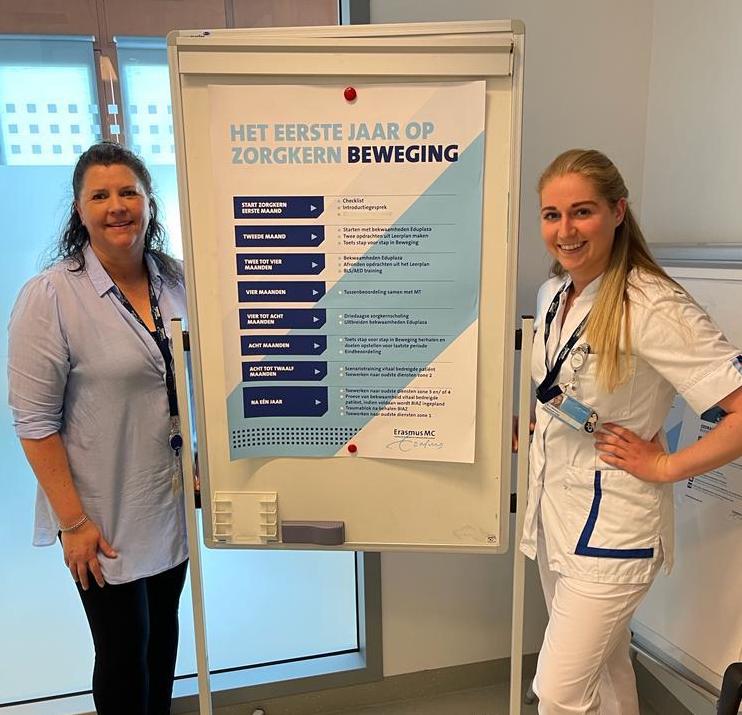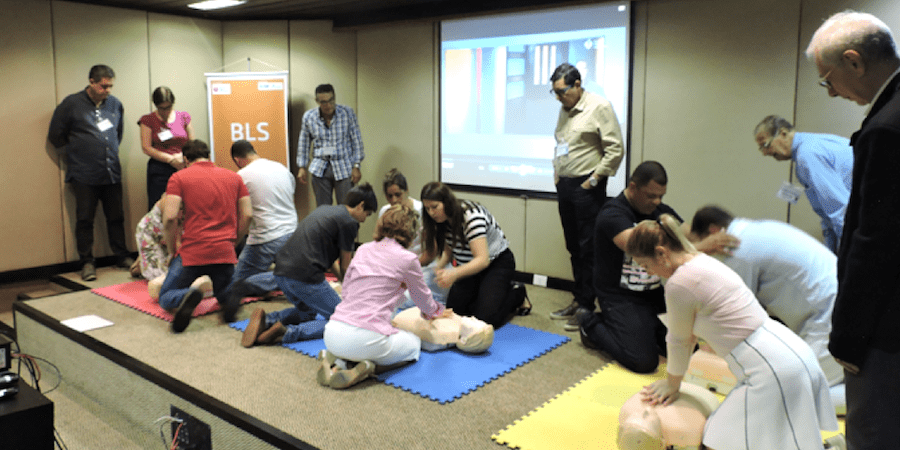
TWI and the reorganization of our work
FEATURE – To facilitate the transition to a new organization of the work in their department, a group of nurses at Erasmus Medical Center have been using Training Within Industry.
Words: Tineke Moerman and Melissa Masson
As part of the recent reorganization at Erasmus Medical Center, four surgery specialties (plastic, orthopedic, dermatology and traumatology) were integrated into one nursing division. While our nurses now have the opportunity to specialize in four different disciplines, this also entails a lot of work to learn new skills. Coupled with our high turnover – we recently had to onboard 18 new nurses within three-four months, who represent nearly half of our 40-strong department – this created the perfect storm.
The need to quickly onboard newly hired people and to help nurses learn new skills so they can easily work across the four specialties led us to explore new approaches to training. Lean came to the rescue: in particular, Training Within Industry appeared to be the solution to our problems.
We started with TWI in orthopedics. Our first move was to break the thick manual new people traditionally received for their onboarding into smaller parts that are more easily digestible.
As I wrote the Job Instructions for each procedure, it quickly became clear to me that what sets TWI apart from other training approaches is the “why” section. Explaining people why they are expected to carry out a certain step in a process is what ultimately makes a difference and helps them to remember the standard.
With new people joining us on a regular basis, standardization has become of the utmost importance for us. Not only because it ensures everyone works in the same way, but also because it allows us to easily track each nurse’s progress. Thanks to a Skills Matrix, we are able to assess everyone’s skills level and fill the gap as needed. This tool helps us to gradually take everyone to the same level of capability. (For the organization, TWI means we have been able to set clear operational goals specific to people development, whereas traditionally we only set quality ones.)
If, for example, a nurse is missing certain skills in one of the four disciplines we cover, TWI tells us immediately what those skills are and allows us to create a development plan tailored to that person’s needs. In this sense, it gives everyone a path for self-development, with self-assessment and one-on-one coaching ensuring they are on track. Indeed, people love TWI not only because it gives them detailed information on how to perform the work, but also because they now have a learning trajectory to follow.
We have been running the TWI program for around 10 months (with the help of Lean Management Instituut), and the rest of the hospital is already showing an interest in starting it in other departments. I also presented it to management, and it was very well received.
THE RESULTS
From an operational standpoint, I can say with confidence that, as we become more used to standards, we are getting better at finding problems. With A3 Thinking (another approach our people love), we are then able to solve those problems once and for all, learning to identify their root causes to ensure they don’t resurface further down the line.
Another clear benefit of TWI lies in talent acquisition and retention. Being a nurse is tough: the job itself is demanding, of course, and the initial training meticulous. Traditionally, many people left one or two months into the program, whereas with TWI, we are seeing less and less dropouts. In fact, at job interviews, we are hearing that people are interested in coming to work here precisely because of our TWI-based training: it makes the course less daunting, especially for professionals coming to the hospital from elderly care (for them, the leap is normally bigger).
There is no doubt TWI is a strategic asset for our hospital because it’s helping us to retain talent and even attract new people – which is incredibly important for an organization with high turnover of staff. When we started, I never thought it would be so successful and I couldn’t be happier to see lean succeed so much in our department.
LEAN AT ERASMUS
Our efforts with TWI are of course part of the organization’s wider lean transformation (you can read more about it in this interview with our Director Kjeld Aij).
Much of our lean work is focused on putting more and more emphasis on patient value. We run a lot of patient surveys in our department, and we used the results to inform the next steps in our improvement journey. When one of our patients raised the problem of nurses not being present enough (the analysis of the problem revealed that they spent as little as 25 minutes a day with patients), that immediately became the focus of one of our A3s.
When I started working here, people used to look at problems from the point of view of the hospital – it was very inward-looking – whereas now we look at what our patients need and tell us. We are trying to change our perspective, having recently started to invite patients to our ward to share their experiences of the care they received.
I believe that our increased focus on standardization and value for patient will increase the number of opportunities to improve that we have. The lessons we learn from our patients and from our previous mistakes are shaping our standards: the top three complaints from patients, for example, have generated two new tasks we have included in our Job Instructions.
We see the TWI program as more than just training; we see it as true learning-by-doing (and improving).
THE AUTHORS

Read more



INTERVIEW – A cardiologist from a hospital in Salvador de Bahia explains how his department was completely transformed following the introduction of a dedicated pathway for heart patients.



VIDEO – Meetings are critical to create a culture based on teamwork and to establish a learning organization, but their traditional format tends to encourage individual agendas. Not Lean Coffee…


FEATURE – In this article we learn how the creation of an Obeya helped an international insurance company boost collaboration among functions and accelerate the delivery of an important IT project.


CASE STUDY - A Turkish shipyard and engineering company has found that lean principles and practice are the only way to deliver unique, large construction projects efficiently and successfully.

